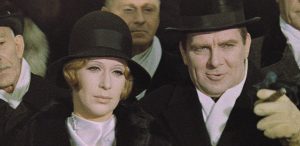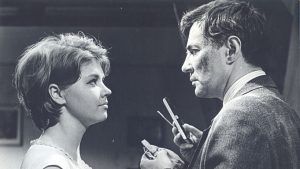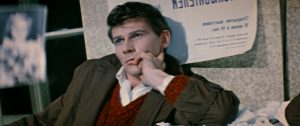Latvian cinema celebrates its centenary in 2020. The first national drama film, Es karā aiziedams / As I Go Off to War premiered on November 9, 1920.
Following the founding of the Republic of Latvia on November 18, 1918, and the War of Independence (1918–1920), the cinema industry in Latvia essentially developed along with the young country, attempting to define its mission, seeking the most appropriate forms of institutional representation and public communication, and also contemplating whether the content and artistic expression in its films should be universal or more locally specific. As he began working on Latvia’s first film, producer Kārlis Kārkliņš had envisioned “popularising Latvians abroad and consolidating a national consciousness in Latvia”.[1]
As I Go Off to War initiated the genre of historical drama in Latvian cinema. In such films, events that were important in the founding of the nation serve as reference points and a driving force for their fictional narratives; the events also determine the actions, character, emotions and interpersonal relationships of the protagonists.
During Latvia’s first period of independence, historical dramas became a popular film genre that was rooted at the same time in mythology and real events.
These films let us observe the First World War, and sometimes also the 1905 revolution, as a catalyst in which Latvian men (so far, only men!) come of age and become a force in the main, decisive struggle, namely, the struggle for freedom and the founding of their country. But also for their sweethearts and their own little patch of the native land…
Unfortunately, As I Go Off to War and several other films made in the 1920s have not survived to the present day. However, we do have the original and restored version of Lāčplēsis (1930), which is not only a unique work of art per se but can also be seen as an assemblage and culmination of trends in Latvian silent cinema in terms of plot and cinematography as well as its set of protagonists and antagonists and interpretation of specific historical events. A film critic who attended the film’s premiere (on March 3, 1930) commented: “The film has turned out very well and is the most valuable film made in Latvia. It documents the creation of Latvia and immortalises in the eyes of the public the people active in this era. By conveniently linking historical events to the love story of Jānis Vanags, who is an heir to the spirit of Lāčplēsis [the Latvian epic hero – Ed.], certain scenes in the film captivate the audience to such an extent that there was not a dry eye in the whole hall.”[2]
Beginning in the later 1930s, films made in Latvia – by then already enjoying state financial and institutional support – gradually sought to enter the global cinema mainstream, which, according to film theorist André Bazin, was almost everywhere based on the same principles of composition and editing.[3] These were 1) “spatial verisimilitude, whereby the position of the character is always determined, even when a close-up cuts out the décor” and 2) “the intention and effect of [the film’s] breakdown are exclusively dramatic or psychological.”[4]

In the history and theory of cinema, the mainstream is largely referred to as “classical cinema”, according to the concept and criteria developed by David Bordwell and Kristin Thompson in their fundamental study The Classical Hollywood Cinema.[5] Considering the fact that, as an aesthetic system, classical cinema is closely linked to film production, that is, the film studio system, we can justifiably speak of classical Latvian cinema as a specific stylistic direction that began along with the Soviet period in 1940, reaching its peak in the 1970s and 80s, when the Riga Film Studio was releasing seven or eight feature films annually in a strictly controlled production cycle as well as a regular, planned number of documentaries, film journals and animated films. These unified, or classical, basic principles of filmmaking merged quite organically with the Socialist Realism proclaimed as the official style in the Soviet Union, resulting in an easily understandable and engaging illusion of reality on screen that was permeated by specific ideas.
Nevertheless, the phenomenon we today call classical Latvian cinema (and which filmas.lv presents to the public) is linked not so much with a body of films created in a unified style as it is with specific films that stand out from the others due to their complex narratives and multifaceted characters or their particularly expressive, idiosyncratic audiovisual solution.
Leonīds Leimanis (1910–1974), who directed the extremely popular film Purva bridējs / The Swamp Wader (1966; 22.5 million viewers in the Soviet Union in the first five months following its release), was
possibly the first person at the Riga Film Studio to realise how to conform the methods of Socialist Realism, as well as the related classical filmmaking techniques, to his own aesthetic interests.
By weaving Socialist Realism stereotypes (the master-servant confrontation in the countryside, the deplorable condition of the proletariat in capitalist cities, saboteurs in the Soviet system) into the background of his cinematic story, Leimanis was able to place what really mattered to him, the things he believed cinema was really about, at the forefront: tragic passions, fateful clashes, the might of nature, beautiful people, the dialectics of life and death.
Aloizs Brenčs (1929–1998) and Jānis Streičs (1936), whose careers directing feature films began in the 1960s, also succeeded in subordinating the classical studio system to their artistic interests. The spy thriller Kad lietus un vēji sitas logā / When the Rain and Wind Knock at the Window (1967) by Brenčs is considered the Latvian cinematic culmination of the beloved Soviet narrative about the KGB’s battle against members of national resistance movements, or, in the Soviet terminology, bandits (in Lithuania this narrative was superbly represented by Nobody Wanted to Die [1966, Vytautas Žalakevičius]). Despite arranging the protagonists and antagonists in line with communist ideology, Brenčs managed to give the film’s main character, the spy Leinasars from abroad, a fascinating and very humanly contradictory character, thus making audiences sympathise with him instead of the KGB infiltrator in the resistance movement. In this film, Brenčs made full use of the techniques that came to characterise his directorial style in the 1970s and which he used in several films that went on to become classic crime dramas: a detailed chain of cause and effect in the narrative; a balanced, dynamic rhythm to the film achieved through careful editing, which is enhanced by the film’s score; shooting in a natural environment as close as possible to that of the story’s setting and the characters’ conditions; use of chiaroscuro lighting for a specific, usually dark and mysterious atmosphere; vivid character development for every role, even minor ones; etc.

Mans draugs – nenopietns cilvēks / My Frivolous Friend (1975) was the first big success for director Jānis Streičs, who is beloved by audiences and respected by his fellow filmmakers to this day. He proved that the “my contemporary” theme requested by the Soviet administration could be fulfilled sincerely and in a manner suited to the Latvian cultural space; moreover, the image of the “frivolous person” became a specific concept, or brand, throughout Soviet cinema of the 1970s and 80s. Streičs used the means of expression canonised by classical cinema, at the same time satisfying the requirements of the socialist arts system, and as a result he delivered pleasing, life-affirming, realistic films with mildly didactic messages. Gradually, however, he expanded his boundaries, for example, by appearing clearly as the author of his films and commenting on the action taking place on screen. The themes of his films also became harsher and incorporated the contradictions of human nature and historical events (for example, Svešās kaislības / Strange Passions, 1983).
Streičs is among the few classical Latvian film directors to have continued enjoying a more or less stable career even in the fragmented film production system following the restoration of Latvian independence. He began work on his film Cilvēka bērns / Child of Man (1991) still under the Soviet system, completing it after Latvia had gained its freedom.
Quite symbolically, the film’s story led back to the director’s subjective (and the public’s collective) memory of Latvia’s idealised first period of independence in the interwar years.
Alongside filmmakers who reconciled with or managed to hide their themes and artistic ambitions within the framework constructed by the Soviet cinema system, the ideas of certain filmmakers from the 1960s onwards at both the Riga Film Studio and the Telefilma-Rīga cinema group at Latvian Television took on a more dissident-like nature. These were mostly young people, but sometimes also of the middle and older generation, who had been inspired by the Khrushchev Thaw and called for a reconsideration of how Latvian history and the fates of those affected by it were shown on screen, as well as a more attentive and sometimes critical look at their own era, examining and highlighting the individuals who stood behind the “Soviet people” marching towards communism as a seemingly united whole. Efforts to find new forms of expression and an imaginative visual language for film stories that could evade censorship and offered secret codes for filmmakers to communicate directly with audiences became more pronounced. It is surprising but quite obvious that, within the centralised system of Soviet cinema, where ‘modernist’ was a curse word, trends emerged that were also current in the West at that time and were associated with the flourishing of modernist cinema.[6]

Subjectivity both as the position of the filmmaker and as a deepened interest in the inner world of man in all its contradictions; reflexivity as the discovery of the nature of cinema and as a visible reflection on the possibilities provided by this medium – these were traits that appeared in Latvian documentary cinema of the 1960s in the work of Herz Frank, Aivars Freimanis, Uldis Brauns, Ivars Seleckis and others. Originally called the Riga style, this language of cinema based in metaphors was later named the Riga School of Poetic Documentary Cinema. The documentary poetics created in the 1960s proved in the 70s and 80s to also be compatible with the growing interest of documentary filmmakers in social and political issues. Director Juris Podnieks (1950–1992) became the most vivid representative of this symbiosis.
Ironically, the same efforts that were welcomed and even supported by the system in Latvian documentary cinema were generally not allowed in feature films,
with the regime reacting sharply and trying to stop any attempt to move away from the aesthetics of Socialist Realism or comment satirically on the times. A characteristic example of this attitude is Četri balti krekli / Four White Shirts (1967, titled Elpojiet dziļi / Breathe Deeply in the Soviet era), which employs elements of alienation so typical of modernism: music as commentary on the action in the film; reflective, “eventless” scenes; occasional emphasis on a “flat” screen; the merging of documentary characters and a fictitious environment; satire and irony; etc. The film was shelved and released only in 1986, during Gorbachev’s era of perestroika. Fifty years after being filmed, Four White Shirts was included in the Cannes Classics section of the 2018 Cannes International Film Festival and finally achieved what it had long deserved – the context of global classical cinema.
We hope that the collection of restored films at filmas.lv will arouse broader interest in Latvian cinema and allow it to be viewed as an integral part of global cinema art.
Inga Pērkone, Dr. Art.
References:
1 – Latvijas Tirgotājs, No. 1, 1920.
2 – Iekšlietu Ministrijas Vēstnesis, 1930.04.03.
3 – Bazin, André, “The Evolution of Film Language”, http://www.newwavefilm.com/about/evolution-of-film-language-bazin.shtml.
4 – Ibid.
5 – Bordwell, D., Staiger, J., Thompson, K., The Classical Hollywood Cinema: Film Style and Mode of Production to 1960, Routledge, 2006. However, some have sharply criticised this concept of classical cinema, and alternative descriptions of mainstream cinema have been proposed. See, for example: Gaines, J. M. (ed.), Classical Hollywood Narrative: The Paradigm Wars, Duke University Press Books, 1992; or Gledhill, C., Williams, L. (eds.), Melodrama Unbound: Across History, Media and National Cultures, Columbia University Press, 2018.
6 – See: Kovács, A. B., Screening Modernism: European Art Cinema, 1950–1980, University of Chicago Press 2007